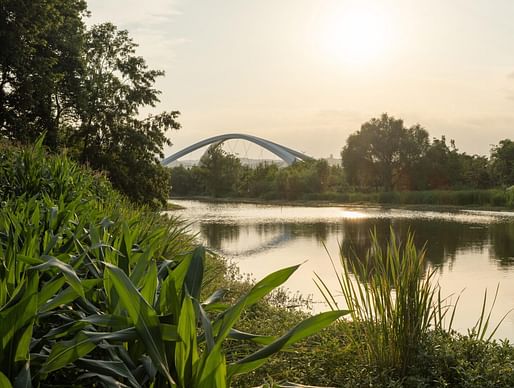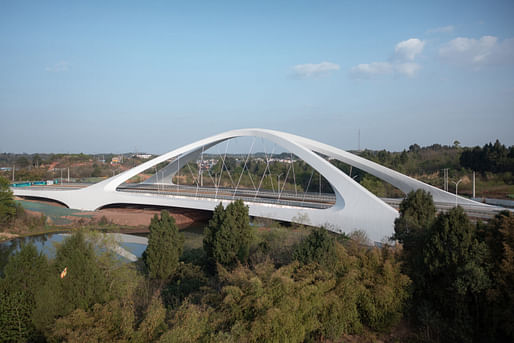
Construction has been completed on the Zaha Hadid Architects-designed Chengdu West First Bridge in China. Spanning 600 feet across the Jiangxi River, the bridge caters to motorists, cyclists, and pedestrians.

The symmetrical bridge comprises two primary steel arches that rise from either side of the road deck. The arches lean together as they rise to touch tangentially at the bridge's peak, offering stability from lateral wind loads.

The bridge’s arches are tied together at their base by longitudinal box girders that run along the edge of the road deck. The ties are designed to counteract the outward horizontal pressure of each arch and thus significantly reduce the horizontal loads on the bridge’s foundations.

“The dynamic curvature of the bridge’s supporting piers and abutments taper into its primary arches and road deck, defining a sculptural landmark within Chengdu’s transport infrastructure,” Zaha Hadid Architects say about the scheme. “Concrete abutments at either end of the bridge incorporate connectors linking the road deck to the West Line Road’s surface. With no foundations in the Jiangxi River, intermediate piers are located beneath the springing points of the arches on each riverbank.”

The bridge’s bored piles and abutments are constructed using in-situ reinforced concrete, with steel box sections for each arch prefabricated and assembled on-site. The edge box girder sections, which include the cable anchorages, were also prefabricated before being spliced together with on-site welding.
The bridge is one of several Zaha Hadid Architects-designed schemes to recently feature in our editorial. Earlier this month, we covered the firm’s Xi’an Tower in China defined by a gently curving silhouette, while in July, we shared an update on a separate bridge designed by the firm in Hangzhou, China. Also in July, the firm opened ‘The New World’ exhibition to mark 15 years of operations in China.
No Comments
Block this user
Are you sure you want to block this user and hide all related comments throughout the site?
Archinect
This is your first comment on Archinect. Your comment will be visible once approved.